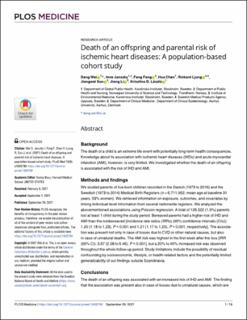| dc.description.abstract | Background
The death of a child is an extreme life event with potentially long-term health consequences. Knowledge about its association with ischemic heart diseases (IHDs) and acute myocardial infarction (AMI), however, is very limited. We investigated whether the death of an offspring is associated with the risk of IHD and AMI.
Methods and findings
We studied parents of live-born children recorded in the Danish (1973 to 2016) and the Swedish (1973 to 2014) Medical Birth Registers (n = 6,711,952; mean age at baseline 31 years, 53% women). We retrieved information on exposure, outcomes, and covariates by linking individual-level information from several nationwide registers. We analyzed the abovementioned associations using Poisson regression. A total of 126,522 (1.9%) parents lost at least 1 child during the study period. Bereaved parents had a higher risk of IHD and AMI than the nonbereaved [incidence rate ratios (IRRs) (95% confidence intervals (CIs)): 1.20 (1.18 to 1.23), P < 0.001 and 1.21 (1.17 to 1.25), P < 0.001, respectively]. The association was present not only in case of losses due to CVD or other natural causes, but also in case of unnatural deaths. The AMI risk was highest in the first week after the loss [IRR (95% CI): 3.67 (2.08 to 6.46), P < 0.001], but a 20% to 40% increased risk was observed throughout the whole follow-up period. Study limitations include the possibility of residual confounding by socioeconomic, lifestyle, or health-related factors and the potentially limited generalizability of our findings outside Scandinavia.
Conclusions
The death of an offspring was associated with an increased risk of IHD and AMI. The finding that the association was present also in case of losses due to unnatural causes, which are less likely to be confounded by cardiovascular risk factors clustering in families, suggests that stress-related mechanisms may also contribute to the observed associations. | en_US |

